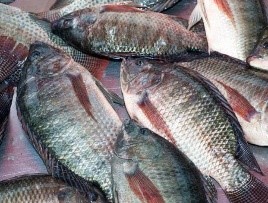Researchers aim to boost production of tilapia native fish species

Sifelani Tsiko
Agric, Environment & Innovations Editor
Researchers from Zimbabwe and Malawi are trying to develop a genetically superior broodstock of tilapia to boost productivity, enhance food security and support smallholder farmers to realise better returns from fish value chains.
Tilapia is one of the most commonly consumed fish in Southern Africa.
Professor Wales Singini of Mzuzu University in Malawi and Prof Tamuka Nhiwatiwa of the University of Zimbabwe, Department of Biological Sciences at the university Lake Kariba Research Station are the principal investigators of the study which aims to produce tilapia fish that grow fast enough to compete economically with other imported ones as well as to help scale up operations beyond subsistence farming.
The researchers want to help address the gaps and to improve tilapia genetics, nutrition and health to a much similar scale used in broiler chickens and egg layers – with hope that it will give tilapia farming a similar production and efficiency boost.
“For a long time, farmers have complained about poor growth performance of indigenous tilapia aquaculture in Malawi and Zimbabwe which has forced some farmers to illegally use exotic species such as carp and Nile tilapia (Oreochromis niloticus),” the researchers said.
“Universities, through the research, will play an important and largely unfulfilled role in contributing to the well-being of small-scale farmers and will provide a platform for national development.”
The R & D pursuits on genetic improvement and mass breeding of tilapias is being undertaken by the Research Council of Zimbabwe (RCZ) in partnership with scientists from the National Commission of Science and Technology in Malawi.
Scientific bodies from Zimbabwe and Malawi are participating in Phase Two of the Science Granting Councils Initiative (SGCI).
A total of 16 African countries, including Zimbabwe, are participating in the SGCI programme.
This initiative was building up on Phase One of SGCI’s objective of seeking to strengthen the capacities of Science Granting Councils (SGCs) in sub-Saharan Africa (SSA) to support research and evidence-based policies that will contribute to socio-economic development.
The joint research on tilapia fish species is jointly funded by the Department for International Development (DFID), now known as the Foreign, Commonwealth & Development Office (FCDO), Canada’s International Development Research Centre (IDRC), South Africa’s National Research Foundation (NRF) and the Swedish International Development Cooperation Agency (SIDA).
Researchers want smallholder farmers to have good tilapia fish breeds that will help tilapia farming to gain traction in the region’s fisheries sector.
The research project will bring together a team of scientists from the two countries to collectively deal with aquaculture challenges in Malawi and Zimbabwe and find appropriate solutions for improving the adoption, production and performance of value chains.
Studies are already being conducted at selected sites on Lake Malawi and at University Lake Kariba Station (ULKRS) as well as at Henderson Research Station in Zimbabwe.
“The overarching goal of the project is to optimize fish production through enhanced breeding techniques among fish farm operators in the northern region geographies of Malawi and Zimbabwe in order to enhance associated value chains performance and improve food and nutrition security, while enhancing environmental sustainability,” said Prof Singini and Prof Nhiwatiwa in a report.
Researchers want to come up with a genetically improved tilapia breed that will be farmed in more places in Malawi, Zimbabwe and Mozambique.
This, they hope, would help southern Africa’s tilapia industry to achieve its goal of exponential growth and to put more fish on plates and feed more people.
They said production of tilapia species in captivity was necessary because environmental degradation and overfishing had reduced their populations on Lakes Malawi, Kariba and other water bodies in southern Africa.
Researchers chose the tilapia species because they have been over-exploited, could help improve local community livelihoods, consumers like them and fish farmers want to raise native species because of their popularity.
Used for thousands of years in subsistence farming, tilapia has grown to be one of the top-10 favourite fish products in Africa and worldwide.
Worldwide, tilapia is the second most commonly consumed farmed fish after the carp species.
The main tilapia producers in the world are China, with about 30 percent of world production, Egypt, Thailand, the Philippines and Indonesia.
Whilst the tilapia industry has grown worldwide, in southern Africa, the developments have been much slower.
Lake Harvest in Zimbabwe was one of the few commercial cage farming enterprises to succeed on the continent.







Comments